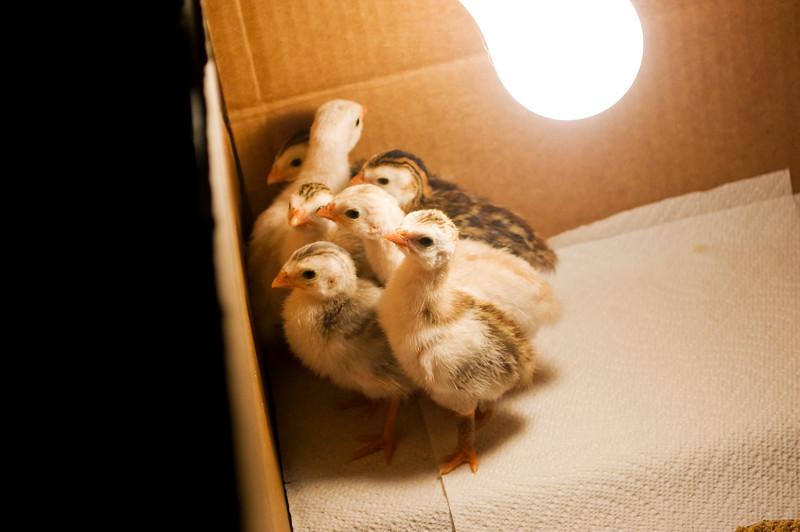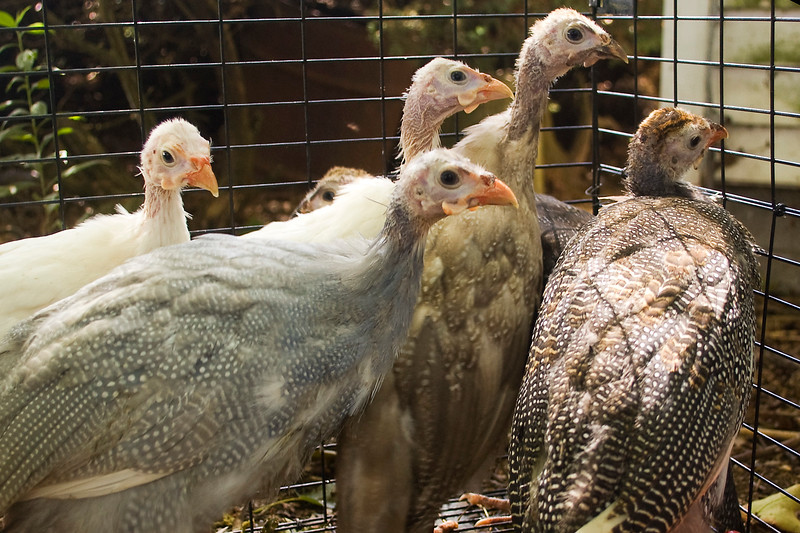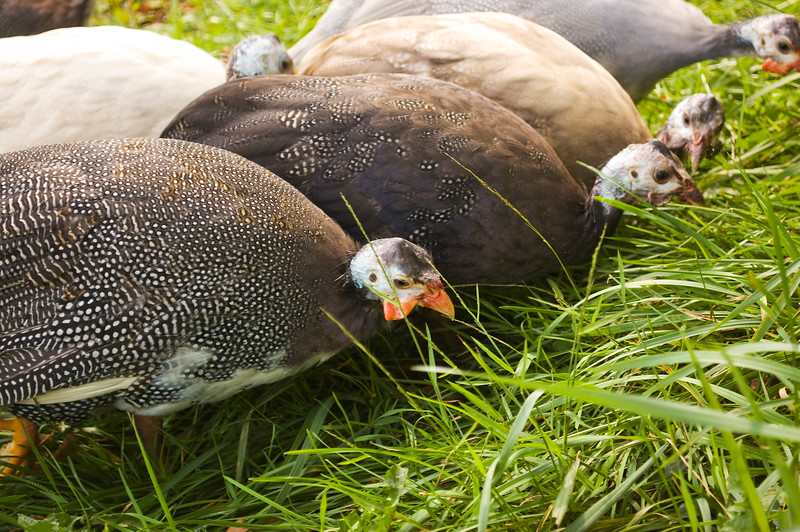Teaching Young Guineas to Range — But Not Too Far!
Audrey Stallsmith shares stories and tips for keeping your free-range loving guineas closer to home.
Time for a New Flock
Many years have elapsed since my elderly parents and I hatched 20 guinea eggs in a homemade incubator constructed from a Styrofoam cooler. Most of the 15 guineas we’d kept for ourselves have since died off, leaving one lone, lame survivor.
He looked so pathetic trying to hang out with the chickens, or limping about on his own, that I decided I should purchase more adult guineas to keep him company. Besides, it seemed a good idea to get a new flock while we had at least one old-timer to remind everybirdy of where home was.

Ramblin’ Birds
I knew all too well about free-ranging guineas’ inclination to “hit the road, Jack” and “come back no more, no more, no more,” since the five we’d given to an aunt hadn’t stayed with her long. Not to mention that the flock we’d had before the incubation had come to us gratis—from one of my sisters—because they’d wandered onto her property from nobody-knows-where.
Upon hearing that the price for a single adult guinea was the same as I would have to pay for a dozen fertile eggs, I decided I would wait until spring and hatch a whole new flock instead of buying one. After all, I had just reconstructed the incubator we’d used so many years ago and successfully hatched chicken eggs in it.
The Price of Eggs
Come May, I contacted a nearby seller via email to reserve a dozen guinea eggs. When she told me they were ready, I looked up driving instructions on MapQuest and sallied forth to find her farm, which turned out to be a partially finished double-wide with a coop or two out front.
When the woman asked whether I needed instructions on how to hatch the eggs, I told her I’d done it before, but most of our birds had since died. She gave me a disapproving look and told me guineas should live for 20 years or more. “The eggs came from Texas. I bought them on eBay,” I said defensively, as if the birds’ early demise might be blamed on their intolerance of Pennsylvania weather.
Those Texas guineas hadn’t seemed inclined to hatch any eggs themselves either. We’d joked that maybe they didn’t understand the facts of life since their mother had been a light bulb.
Refrigerated Hatching Eggs
Now, as the woman handed me my box of eggs, she generously laid a couple extras on top—probably concluding I was going to need them. They felt cold. Surely she knew that eggs meant to be incubated weren’t supposed to be refrigerated? I reminded myself that, since it was spring, the nights were still cool. Perhaps she’d just gathered the eggs from a shaded coop. After meekly paying her, I returned to my car, gingerly cradling the box and its upper deck passengers with a few friendly dogs in tow.
Eggs which had been refrigerated could hatch, after all—though in lower numbers. After wishing the dogs a firm farewell, I took my 14 eggs home and laid them on the floor of the homemade incubator.
Brooding the Keets
Only half of the eggs hatched. I don’t know if this was because the eggs were initially chilled, or whether my tomcat lying on the warm box raised the temperature too much. After the guineas had outgrown their paper-towel-lined box, I couldn’t use the large dog crate which had “brooded” the chickens. My other sister had borrowed that to house a couple ducklings she’d purchased for her daughter. Instead, I bought the largest rabbit cage I could find, which would only fit through the door at an angle. I then plunked it atop a plastic tablecloth in a back room, adding a large branch for a perch.

Young guineafowl, known as “keets” in homemade brooder. Photo by author.
A Bigger Room for the Teenagers
Once the guineas had fully feathered out at 6 weeks of age, I had to do a different kind of brooding—about how to get the ship out of the bottle, so to speak. My sister and her daughter recently had moved out, leaving the ducklings behind, so their care had fallen to me by default. They had already been released, and their dog crate moved outdoors where they could safely return to it every night.

Scruffy teenagers. Photo by author.
One afternoon, I hosed that enclosure clean, hauled it into the house, and transferred all the guineas into it. I then carried the crate outside and left the guineas in the shade before going back to remove the rabbit cage from the house.
That flimsy contraption ended up just outside my bedroom window, where I returned the guineas to it. In addition to being able to hear any commotion caused by predators that way, I also could run an extension cord from my window to the guineas’ lightbulb. While the bulb no longer was necessary to keep them warm, it did help them feel more secure. I kept the cleaned plastic tablecloth nearby, to place over their cage during periods of rain, and found that covering it at night helped them calm down more quickly too.

I then began preparing them for release by moving the cage out into the open, on the edge of the yard, during the day. That way, they could get to know what home looked like. Keets, despite their wandering ways, are birds of habit. If they decide a place is “home,” they generally will remain in its vicinity. I was also counting on the older guineas to discover the younger ones and help teach them the ropes.
Our dog took a proprietary interest in the young birds. She’d enjoyed running through the middle of the prior flock just for the fun of seeing them scatter. Perhaps that was what had taken some of those years off their lives. But at least she often slept near the new guineas’ cage at night, so I really didn’t have to worry much about predators.
Coming up from the garden one day, I caught the older guinea lurking near that cage too. He limped hurriedly away as soon as he saw me coming, but I made a mental note of that my plan seemed to be working.
Venturing Abroad
When I finally got around to releasing the young keets, I had to tip the rabbit cage up a bit on one side to convince them to hop out the open door on the other. Then, they huddled together in a tight group, making every tentative step a group effort. At first, they would flee whenever the older guinea tried to join them, but they eventually grew accustomed to his presence.

Herding Guineas
I’d read online that it’s possible to steer guineas by positioning long sticks on either side of them, so I used a couple of my 4-foot bamboo garden stakes to herd the keets back to their cage after just a couple hours on the first day. After each subsequent release, I left them out a little longer, until they eventually remained free from early morning to suppertime.

As soon as the garden stakes came up on either side of them, the guineas would surge forward at a flat-out run, with me panting along behind, and shifting those sticks as necessary to steer the zooming birds in the right direction. I did eventually have to put barriers up on either side of their cage, though, or some of them would part like a wave and go around it instead of in the door.
Willy Nilly Roosting
They also began to try to roost in the lilac tree near the driveway. Since I could reach them there, it seemed likely a predator wouldn’t have much problem doing so as well. Therefore, if I didn’t make it outdoors in time to forestall their roosting, I would push two or three of them off a branch and steer those ones toward their cage. The others always swooped down to follow us.
Training from the Old Guy
Late one afternoon, I got Dad to help me lift the cage of guineas into the bed of our pickup. We then backed the pickup to the barn door and carried the cage inside, placing it in the large empty box stall which our beef cattle occupied during the winter. Since the older guinea often roosted above that stall, we hoped he would teach the young’uns to do so as well. Sure enough, he followed us to the barn, entering from the back to fly up onto one of the corner joists. I positioned the keets’ cage so they could see him and they shortly began “conversing” back and forth with him.
I then snuck over and opened their cage door. Still chattering away, the keets first flew up onto one of the railings surrounding the stall. But eventually, they all made it up into the high joists—and into their new free-range lifestyle.
Audrey Stallsmith is author of the Thyme Will Tell series of gardening-related mysteries, one of which received a starred review in Booklist, while another earned a Top Pick in Romantic Times. Her e-book of humorous rural romances is titled Love and Other Lunacies. She lives on a small farm in western Pennsylvania.













5 Comments
Thanks Audrey for this tips about Guinea fowl…. I’m planning to get some keets in April and I can’t wait….but we’ve never had them when I was a kid on the farm, so it’s good to read as much as possible.
Enjoyed your 2 articles on guinea keets !
I REALLY appreciated this article! My keets are just a little over 12 weeks old and I’m just now letting one, then two outside at a time..
They come back into the barn (where their coop is) a couple of times just like you said.
Once your keets were all outdoors and then roosting in the rafters, did you just let them remain like that, or do you still herd them back into the coop every evening? I’d love to see mine living loose in my barn like that as long as they’re up high enough to avoid predators.
Next question: I have two medium-sized dogs, one of which killed two of my chickens a few years ago. I hate to keep her tied up, but I want to keep my Guineas (and future chickens) safe and alive. Do you have a proven-successful method of training a dog to leave them alone?
I read somewhere about sitting amongst the flock, with the dog leashed right up next to me, until the dog gets bored and loses interest, but I’ve never seen that recommendation again, or heard anything about it.
Can you please offer some suggestions?
Robynne,
I’m glad you enjoyed my article. Yes, once they learned to go up into the rafters that day, we just let the guineas continue to roost there and didn’t try to keep them confined again. Actually, it was getting harder and harder for me to herd them back into that cage anyway!
I wish I did have a solution about dogs and barnyard birds, since I still don’t entirely trust our dog around them, even though I have to admit that she has been very longsuffering with the duck who constantly chases and tries to peck her. She will pin it down with her paw occasionally, but hasn’t tried to hurt it. Still, I have caught her and the dog from down the road harassing a hen a couple different times, though they didn’t seem to have hurt either one very badly. Obviously, dogs behave worse when there is more than one of them.
The only solution I’ve found so far is to yell at the dogs in a growl-y voice whenever they misbehave. which isn’t much of a solution! I also tend to clap my hands sharply together at the same time, because that noise often will get their attention when my voice doesn’t. If you have time for dog training, I’ve guessing that a better solution would be to teach the dogs the command “leave it.” I’m sorry I can’t be of more help.
Thoroughly enjoyed the Guinea Fowl article.In India we bought a pair for our farm,and they multiplied to the point that we had a flock of 40.They all slept high up on the big Mango trees near our house,and at daylight they would all fly over to the roof and gallop up and down.The noise was unbelievable! Amusing,fun birds who kept all sorts of vermin away.I loved them.